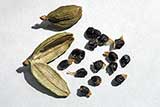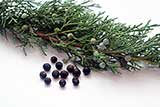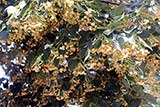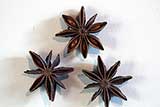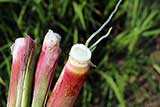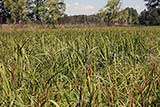Meats and Sausages
Herbs and Spices
The practice of using whole spices such as cloves, vanilla sticks and chopped nutmeg is encouraged as they produce little cloudiness. The best solution is to make them into an infusion which is strained, filtered and applied as needed. Dry herbs and spices are used for making herbal infusions. Such infusions may become a part of herbal liqueurs. There are hundreds of suitable herbs and spices; the most popular follow below:
Herbs: tea, angelica root, wormwood, marjoram, basil, thyme, bison grass, lavender, linden, and elderberry flowers, and dry rose petals. Seeds: anise, fennel, caraway, allspice, cumin, vanilla, almonds, coffee, cacao.
Tree bark: cinnamon, oak, French oak.
There are too many herbs and spices to list them all. We list only those few that are often used and we find them quite original.
Angelica archangelica. The roots and seeds are sometimes used to flavor gin. Its presence accounts for the distinct flavor of many liqueurs, such as Chartreuse and Dom Benedictine.
Cardamom (Elettaria cardamomum) is the world's third most expensive spice by weight, outstripped in market value only by saffron and vanilla. Cardamom has a strong, unique flavor, with an intensely aromatic, resinous fragrance. Cardamom is used as flavorings in both food and drink, as cooking spices and as a medicine. Green cardamom is used in South Asian traditional medicine to treat infections in teeth and gums, to prevent and treat throat troubles, congestion of the lungs and pulmonary tuberculosis, inflammation of eyelids as well as digestive disorders. It is also used to break up kidney stones and gall stones, and was reportedly used as an antidote for both snake and scorpion venom. For recipes requiring whole cardamom pods, a generally accepted equivalent is 10 pods equals 1½ teaspoons of ground cardamom.
Juniper is a bush that grows everywhere in the world, including parks and streets. Its berries are added to wild game dishes, hunter's sausage, and different beverages. Gin's flavor comes chiefly from juniper. Fresh berries are green in the spring, light blue in the summer and navy blue in November. Dry berries are very dark blue and contain about 20% sugar what makes them relatively easy to ferment.
Hyssop (Hyssopus) is used as an ingredient in eau de Cologne and the liqueur Chartreuse. It is also used to color the spirit Absinthe, along with Melissa and Roman wormwood. Hyssop leaves have a slightly bitter minty flavor and can be added to soups, salads, or meats.
Lemon balm (Melissa officinalis), is a perennial herb in the mint family native to southern Europe and the Mediterranean region. It grows in the southern USA as well. The leaves have a gentle lemon scent, related to mint. During summer, small white flowers full of nectar appear. These attract bees, hence the genus name Melissa (Greek for "honey bee"). Lemon balm is often used as a flavoring in ice cream and herbal teas, both hot and iced, often in combination with other herbs such as spearmint. It is also frequently added to herb infusions.
Linden Tree Flowers. Linden trees grow in Europe and in the USA. The street that leads to the famous Branderburg Gate in Berlin is called "Unter den Linden" (under linden trees). Take a cable car to Roosevelt Island in Manhattan and you see them lining up the streets. They are tall, the flowers produce a wonderful fragrance and we have been making linden tea for millennia. So next June when you pass a linden tree pick up some flowers and treat yourself to delicious tea that tastes like honey. Because of their aroma they are often added to infusions, sometimes with rose petals.
Star anise (Illicium verum) is used in baking as well as in liquor production, most distinctively in the production of the liquor Galliano and Sambuca, Pastis, and many types of absinthe. It goes well with peppermint and apple.
Sweet flag (Acorus calamus), also known as Calamus is a tall perennial wetland weed. The scented leaves and more strongly scented rhizomes have traditionally been used medicinally and to make fragrances. The dried and powdered rhizome has also been used as a substitute for ginger, cinnamon and nutmeg. In Europe Acorus calamus was often added to wine, and the root is also one of the possible ingredients of absinthe. Acorus calamus is found across Europe, Southern Russia, Northern Asia Minor, Southern Siberia, China, Indonesia, Japan, Burma, Sri Lanka, Australia, as well as Southern Canada and the Northern United States. From Wikipedia: Sweet flag has been an item of trade in many cultures for thousands of years. It is widely employed in modern herbal medicine due to its sedative, laxative, diuretic, and carminative properties. It is used in Ayurvedic medicine to counter the side effects of all hallucinogens. Sweet flag is one of the most widely and frequently used herbal medicine amongst the Chipewyan people. Both roots and leaves of A. calamus have shown antioxidant, antimicrobial and insecticidal properties.
Vanilla. Vanilla is probably the most important spice for making sweet vodkas, liqueurs and crèmes. In many countries it is available in the form of original vanilla pods which weigh about 3-4 g each. They can be added directly to infusions or a vanilla infusion can be made from them. Then the filtered vanilla infusion is added in its liquid form to any recipe that calls for vanilla. In the USA factory made natural vanilla extracts are commonly available making home production of liqueurs much simpler.
Vanilla Infusion
- Vanilla sticks (3), 10 g
- Alcohol 70%, 90 ml
- Split vanilla sticks and cut into 1 cm pieces. Macerate for 3 weeks, filter and bottle.
The 2nd Infusion Method
Vanilla is an expensive spice so it makes sense to retrieve as much of it as possible. The second infusion method does just that.
- Vanilla, 10 g
- Alcohol 70%, 70 ml
- Alcohol 50%, 50 ml
- Split vanilla sticks and cut into 1 cm pieces. Add 70 ml 70% alcohol and macerate for 3 weeks. Filter and bottle. This is your first infusion. Save vanilla cuts.
- Add 50 ml 50% alcohol and macerate for 3 weeks. Filter and bottle.
- Combine both vanilla infusions.
Wormwood (Artemisia absinthium), is an ingredient in the spirit absinthe, and is also used for flavoring in some other spirits and wines, including bitters and vermouth. In the Middle Ages, it was used to spice mead. In 18th century England, wormwood was sometimes used instead of hops in beer. The aperitif vermouth (derived from the German word Wermut, "wormwood") is a wine flavored with aromatic herbs, but originally with wormwood. The highly potent spirits absinthe and Malört also contain wormwood. Polish vodka Zoladkowa Gorzka is flavored with wormwood. Run a test first as wormwood is very bitter.

